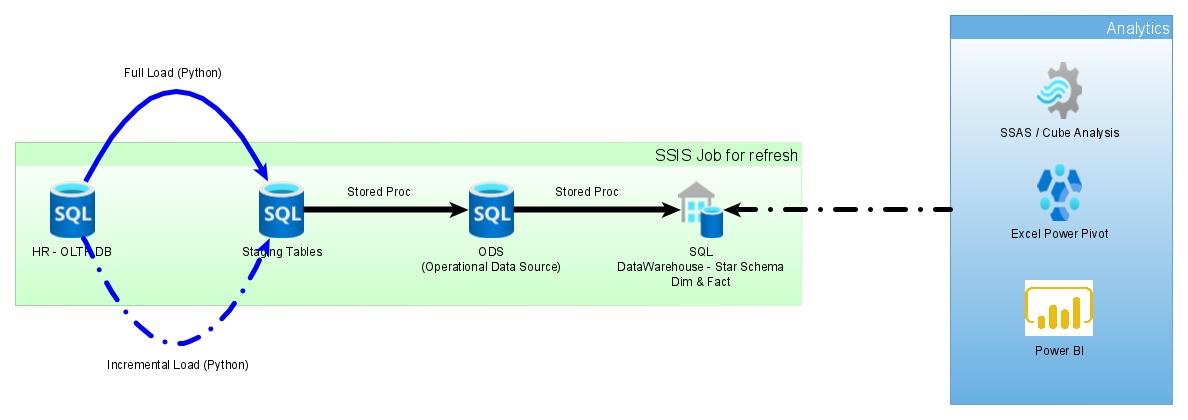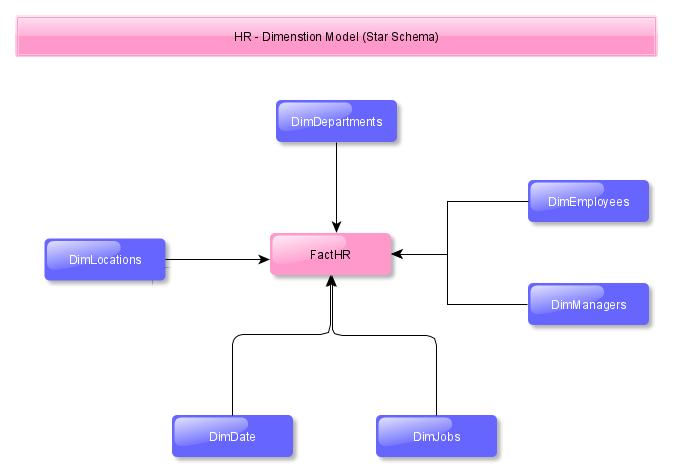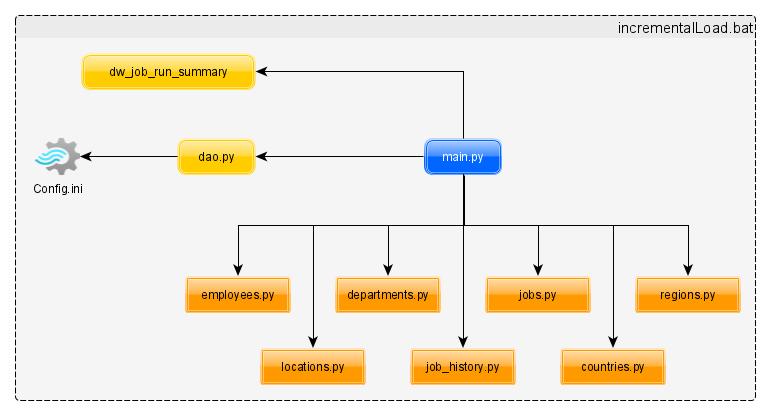- Data Warehouse - 1 - Establish Connection using Python for Full Load - https://youtu.be/d8BcIFI1YSc
- Data Warehouse - 2 - Creating CSV file using Pandas DataFrame for Full Load - https://youtu.be/GOH6NS4kNf0
- Data Warehouse - 3 - read_csv of DataFrame & insert records from python for Full Load https://youtu.be/4HBIDX2j9Eg
- Data Warehouse - 4 - read_csv of DataFrame & insert records from python for Full Load https://youtu.be/TOG_8WHsjFc
- Data Warehouse - 5 - Exception handling in python for Full Load https://youtu.be/tiA-ZkuVRdE
- Data Warehouse - 6 - Logging Success and Error Message for Full Load https://youtu.be/TfmmvddDcJU
- Data Warehouse - 7 - Global Variable for Full Load https://youtu.be/oQouHYIuRDs
- Data Warehouse - 8 - Understanding ODS Data and Structure https://youtu.be/JEtmLpyDL5g
- Data Warehouse - 9 - Loading ODS Table using Stored Proc https://youtu.be/wKvaDRFo7nw
- Data Warehouse - 10 - Automate ODS Load using SSIS Package https://youtu.be/jRMMNn2s9aw
- Data Warehouse - 11 - Load Dim Tables using Stored Proc https://youtu.be/urLBGp3_3PY
- Data Warehouse - 12 - Load Date Dim using Excel Formulae https://youtu.be/tCM1bJO7_N0
- Data Warehouse - 13 - Load Employee Dim using Stored Proc https://youtu.be/teAIA_Ko9AE
- Data Warehouse - 14 - Load Manager Dim using Stored Proc https://youtu.be/IS5rHOxBLto
- Data Warehouse - 15 - Load Fact table using Stored Proc https://youtu.be/JA-lwCjmWhI
- Data Warehouse - 16 - Creating SSAS Multidimensional Cube for Reporting https://youtu.be/VP7Om7G2EkI
- Data Warehouse - 17 - Improving SSAS Multidimensional Cube for Reporting https://youtu.be/9dMYpRxGaoI
- Data Warehouse - 18 - Process SSAS Cube using SSIS package https://youtu.be/OF40ZEaxN8s
- Data Warehouse - 19 - Schedule SSIS package using SQL Job https://youtu.be/8MpR7FUz3p0
- Data Warehouse - 20 - Incremental Load Using Python - Part1 https://youtu.be/F2wtnpChrpY
- Data Warehouse - 21 - Converting Fact from TruncReload to DeleteInsert - Part2 https://youtu.be/NEflh6pZiZw
- Data Warehouse - 22 - Incremental Load Using Python - Part3 https://youtu.be/NkGbvWq3mmE
- Data Warehouse - 23 - Reporting using Excel Power Pivot https://youtu.be/NuQF__HUytU
- Data Warehouse - 24 - Reporting using Power BI https://youtu.be/MjuLCctMUIQ
- Data Warehouse - 25 - Reporting using Tableau https://youtu.be/E_kEeW5Ea5k
- SQL Server (or any relational database)
- Python for ETL
- SSAS / Excel for reporting
- Sample data of HR schema for this was downloaded from https://github.com/oracle/db-sample-schemas/releases/tag/v12.2.0.1
- Vishal Studio Code
Following image depicts data flow of data-warehouse system from Transactional System -> Till Data Warehouse Star Schema and then reporting with different options bassed on DW data.
 As you can see in diagram
As you can see in diagram
- Transaction DB -- Data from transaction DB (HR db in this case) we move to staging table first on daily (or weekly / monthly based on need) basis using Full or Incremental Load. In this case we will use Python for ETL, you can use any other tool such as Informatica, SSIS etc. for this.
- Staging Table -- Structure of Staging tables are exactly same as transaction DB, except it has 2 more columns of CreationDate & UpdationDate to document when table was last refreshed. Staging tables are mostly truncate & reload
- ODS (Operational Data Source) -- Data from multiple Staging tables will be combined into single ODS table; also ODS table stores historical data (insert only)
- DataWarehouse -- Data from ODS will be loaded into Dim (Non Measureable Attribute) & Fact (Measurable Attributes) on daily (or weekly / monthly based on need) basis. In this case load from ODS till DW will happen using Stored Proc
- Reporting -- Final reporting will happen using SSAS Cube(Tabular model), Excel Power Pivot, or Power BI. (you can use any tool such as SQL, BO, OBIEE for data analysis)
In this case, we are going to use Python for ETL (Extraction Transform Load), and there are 2 ways we are going to see
- Full Load -- Pulling entire data from source tables to staging tables
- Incremental Load -- Only pulling delta records (updated or newly created records) from source tables to staging tables We will see difference between these 2 types and when to use each particular type. Following image ETL using Python which we are going to see in this example
https://stackoverflow.com/questions/51820189/retrieve-data-from-sql-server-database-using-python
import pyodbc
cnxn = pyodbc.connect("Driver={SQL Server Native Client 11.0};"
"Server=mySRVERNAME;"
"Database=MYDB;"
"uid=sa;pwd=MYPWD;"
"Trusted_Connection=yes;")
cursor = cnxn.cursor()
cursor.execute('select DISTINCT firstname,lastname,coalesce(middlename,\' \') as middlename from Person.Person')
for row in cursor:
print('row = %r' % (row,))
https://stackoverflow.com/questions/19379120/how-to-read-a-config-file-using-python
[My Section]
path1 = D:\test1\first
path2 = D:\test2\second
path3 = D:\test2\third
import ConfigParser
config = ConfigParser.ConfigParser()
config.readfp(open(r'abc.txt'))
path1 = config.get('My Section', 'path1')
path2 = config.get('My Section', 'path2')
path3 = config.get('My Section', 'path3')
https://stackoverflow.com/questions/14087598/python-3-importerror-no-module-named-configparser
ETL Load from OLTP system to Staging tables can happen by
- Database to Database -- Both systems - OLTP & Staging - are in different environments, you can directly load data from OLTP to Staging, however, this will keep the connection open to source OLTP till the time load to Staging gets finish. For small datasets, this will work, but if you have millions of records in source, then keeping connection open is not a good idea.
- Database to Flat File -- It's always advisable to load data from OLTP to Flat File first and then into Staging. Remember, loading data into (or from) Flat File from OLTP will take considerably less time and this way you don't have to keep your source(or target) connection open for longer period.
Next task is to get records from database into a list. You can refer code from https://docs.python.org/3.3/tutorial/datastructures.html.
Python-Pandas Dataframe is very easy & convenient way to deal with data and for ETL we will use that. You can refer my earlier videos https://youtu.be/ZtXMnCw10Og (2 mins 13 sec) & https://youtu.be/9sjT8EsaoYA (3 mins 58 sec) of using "iloc" of Pandas DataFrame.
Once DataFrame is created, use to_csv methond of python to export data into csv file.
Once you create separate csv file for each transaction table which you want to load into staging area, next task is to read those csv files into data frame. For that use read_csv method of pandas dataframe which will return DataFrame object. You can refer https://www.shanelynn.ie/python-pandas-read_csv-load-data-from-csv-files/ for more details
Once data frame is created - which will consists of multiple records for each table - you need to insert those records into staging table. So, inorder to iterate DataFrame you can use following code
import pandas as pd
df = pd.DataFrame({'c1': [10, 11, 12], 'c2': [100, 110, 120]})
for index, row in df.iterrows():
print(row['c1'], row['c2'])
More information is available at https://stackoverflow.com/questions/16476924/how-to-iterate-over-rows-in-a-dataframe-in-pandas
To insert each record from DataFrame, use following python code
cnxn = pyodbc.connect('DRIVER={SQL Server};SERVER='+server+';DATABASE='+database+';UID='+username+';PWD='+ password)
cursor = cnxn.cursor()
### Insert Dataframe into SQL Server:
for index, row in df.iterrows():
cursor.execute("INSERT INTO HumanResources.DepartmentTest (DepartmentID,Name,GroupName) values(?,?,?)", row.DepartmentID, row.Name, row.GroupName)
cnxn.commit()
cursor.close()
for more details you can visit https://docs.microsoft.com/en-us/sql/machine-learning/data-exploration/python-dataframe-sql-server?view=sql-server-ver15
To handle null values in DataFrame use following code
dataFrame.fillna("", inplace=True)
For more details please visit https://pandas.pydata.org/pandas-docs/stable/reference/api/pandas.DataFrame.fillna.html
Exception handling in python is somewhat similar to other languages such as Java or c#, we will be using following code
# import module sys to get the type of exception
import sys
randomList = ['a', 0, 2]
for entry in randomList:
try:
print("The entry is", entry)
r = 1/int(entry)
break
except Exception as e:
print("Oops!", e.__class__, "occurred.")
print("Next entry.")
print()
print("The reciprocal of", entry, "is", r)
more information on this is available at https://www.programiz.com/python-programming/exception-handling
You can use following code
df.index = [1, 2, 3]
df.columns = ['a', 'b', 'c']
print(df)
# a b c
# 1 11 12 13
# 2 21 22 23
# 3 31 32 33
More details are available at https://note.nkmk.me/en/python-pandas-dataframe-rename/
https://www.programiz.com/python-programming/datetime/current-datetime
Why its needed?
- To understand if our load failed or it was succeeded
- If failed, then what was the error?
- If succeeded, how many records it pulled?
- How long our jobs are taking to finish? how much data we are pulling everyday over a period of time?
CREATE TABLE [dbo].[dw_job_run_summary](
[id] [int] IDENTITY(1,1) NOT NULL,
[tablename] [varchar](100) NULL,-- table which is getting loaded
[start_date_Time] [datetime] NULL, -- date time on which load has started
[end_date_Time] [datetime] NULL, -- date time on which is load has finished
[rows_processed] [int] NULL, -- number of rows processed
[status] [varchar](15) NULL, -- status of load (fail or success)
[error_message] [varchar](2000) NULL, -- if failed, then error message
[colid] [bigint] NULL,-- if failed, then which row failed
[job_run_id] [int] NULL, -- indicates how many times the process has ran
[created_on] [datetime] NULL default getdate() -- date when record got created
)
Keep only 1 ODS table, and try to add maximum columns in that. Following is the table structure I have defined, but I forgot to add measurable attributes into it e.g. Salary, Max Salary, Min Salary, Commission Pct etc.
Create table ODS_HR
(
id int IDENTITY(1,1) PRIMARY KEY
, EMPLOYEE_ID int
, FIRST_NAME varchar(50)
, LAST_NAME varchar(50)
, EMAIL varchar(60)
, PHONE_NUMBER varchar(30)
, StartDate DateTime2(3)
, EndDate DateTime2(3)
, JOB_ID varchar(30)
, MANAGER_ID int
, DEPARTMENT_ID int
, DEPARTMENT_NAME varchar(50)
, LOCATION_ID int
, CITY varchar(50)
, STATE_PROVINCE varchar(50)
, COUNTRY_NAME varchar(50)
, REGION_NAME varchar(50)
, SALARY Decimal(13,2)
, COMMISSION_PCT Decimal(5,2)
, CreatedOn DateTime2(3) DEFAULT getDate()
, UpdatedOn DateTime2(3) DEFAULT getDate()
)
ODS Load we can do using any ETL tool, however in this video series I have used Stored Proc. You will find that SP in repisitory. Also, both Staging Load and ODS Load I have combined into single SSIS package, which we can automate later on. Note - In this case I have use Insert - Update stragegy, you can go for Delete \ Insert as well but that's not advisible.
You can configure Data Warehouse mainly by two ways, Dimentional Modeling or 3NF Modeling - for more information you can refer to link - http://roelantvos.com/blog/comparisons-between-data-warehouse-modelling-techniques/
However, for this implementation we are going to implement simple Dimentional Model, which is as follows

All non-measurable attributes we are going to keep in Dimention Tables. In our case, we are going too create following dimenstion tables. Also, Dimentation tables maintains historical records (same as ODS). You can also implement different SCD (Slowly Changing Dimentions) types based on business need, however for this video we are not going to implement it to keep things simple as we can.
- DimLocations -- Location, Country and Region records are combined into a single dimention table
- DimDepartments
- DimJobs
- DimEmployees
- DimDate
For any Data Warehouse implementation, you should have a separate date dimention. Now, columns in your date dimentions can very based on the business \ reporting need. There are several insert scripts you can find if you google it, few links I have specified below
- https://www.sqlshack.com/implementing-different-calendars-in-reporting/
- https://stackoverflow.com/questions/5635594/how-to-create-a-calendar-table-for-100-years-in-sql
However, for this video, we are going to use Excel. Using Excel formulae specified below, we will first create data as required, and then prepare insert statements using it. We are going to create following columns in Date Dimentions along with their Excel formulae.
- CalendarDate -- will be populated manually (its only for Excel)
- month_id -- =Month(B2)
- month_desc -- =TEXT(B2,"mmmm")
- qurater_id -- =IF( OR(C2 = 1, C2=2, C2 = 3),1, IF(OR(C2 = 4, C2=5, C2 = 6),2,IF(OR(C2 = 7, C2=8, C2 = 9),3,4)))
- qurater_desc -- ="Qtr " & REPT("0",2 - LEN(E2)) & E2
- year_id -- =YEAR(B2)
- day_number_of_week -- =SWITCH(I2,"Sunday",1,"Monday",2,"Tuesday",3,"Wednesday",4,"Thursday",5,"Friday",6,"Saturday",7)
- day_of_week_desc -- =TEXT(B2,"dddd")
- day_number_of_month -- =DAY(B2)
- day_number_of_year -- =B2 - DATE(YEAR(B2),1,0)
- week_number_of_year -- =WEEKNUM(B2)
- year_month -- =YEAR(B2) & "-" & REPT("0",2 - LEN(C2)) & C2
- calendar_date -- = '2021-01-02',
- date_id -- =YEAR(B2) & REPT("0",2 - LEN(C2)) & C2 & REPT("0",2 - LEN(J2)) & J2
Create Table DimDate
(
DateDimKey int
, calendar_date varchar(10)
, month_id smallint
, month_desc varchar(15)
, qurater_id smallint
, qurater_desc varchar(6)
, year_id int
, day_number_of_week smallint
, day_of_week_desc varchar(15)
, day_number_of_month smallint
, day_number_of_year smallint
, week_number_of_year smallint
, year_month varchar(7)
)
All measurable attributes we keep in Fact table. Though there are many Dim tables in DW implementation, there can be 1 (max 2 or 3) fact in DW implementation. In our case, we are going to keep only 1 Fact table. To populate Surrogate Keys to Fact tables,
- you can either use Staging tables joining with corresponding DIM tables
- or you can use ODS table joining with corresponding DIM tables. Using ODS table will be much easier as since it will reduce joins between staging tables and ultimately the query complexity.
Also, main challenge in populating Fact (or even ODS & Staging tables for that matter) is incremental load. As of now we are going by Full Load, which is a very bad practice as per my knowledge. If there are millions of records in OLTP systems, full load will take forever to finish the load. and since its a Full Load, so while Fact Load we will go as Truncate & Reload.
In next few videos we will see how (and why) can we change this FULL Load to Incremental Load. However, incremental load is a challenging task. All depends on how source system is built.
- If OLTP source has always incremental records (no updates), then we can keep ODS and Fact as always insert.
- If OLTP source is Insert \ Update then ODS we may need to keep Delete\Insert (most of the times) or Update\Insert
- There can be many cases which I can not think of.
Also, while pulling records from source tables into Staging tables incrementally, we have to be very careful.
- We need to pull records by Creation Date and Updation Date
- We need to pull records from Transation Table, but their correspodning records from master table. As we need master table join in ODS or DIM\Fact load.
- It would be good if we have FULL load for Master tables and Incremental Load for Transaction Table.
All above scenarios I just documented based on my small knowledge, unless we work on real problem, we will never come to know the actual solution. and since every problem is different, their solutions will also differ.
Whether its OBIEE, Business Objects, Power BI, SSAS Cube (MultiDimentional or Tabular). Power Pivot or even Tableau - in order to make reports, you need to follow following generic things.
- Select your tables by creating Connections
- Define relationships among those tables
- Select your Dimensions Attributes (non-measurable) & Facts (Measurable Attributes)
- Hide attributs \ Fields which are not needed
- Create Views as per need for reporting
- Create derived columns as per need
